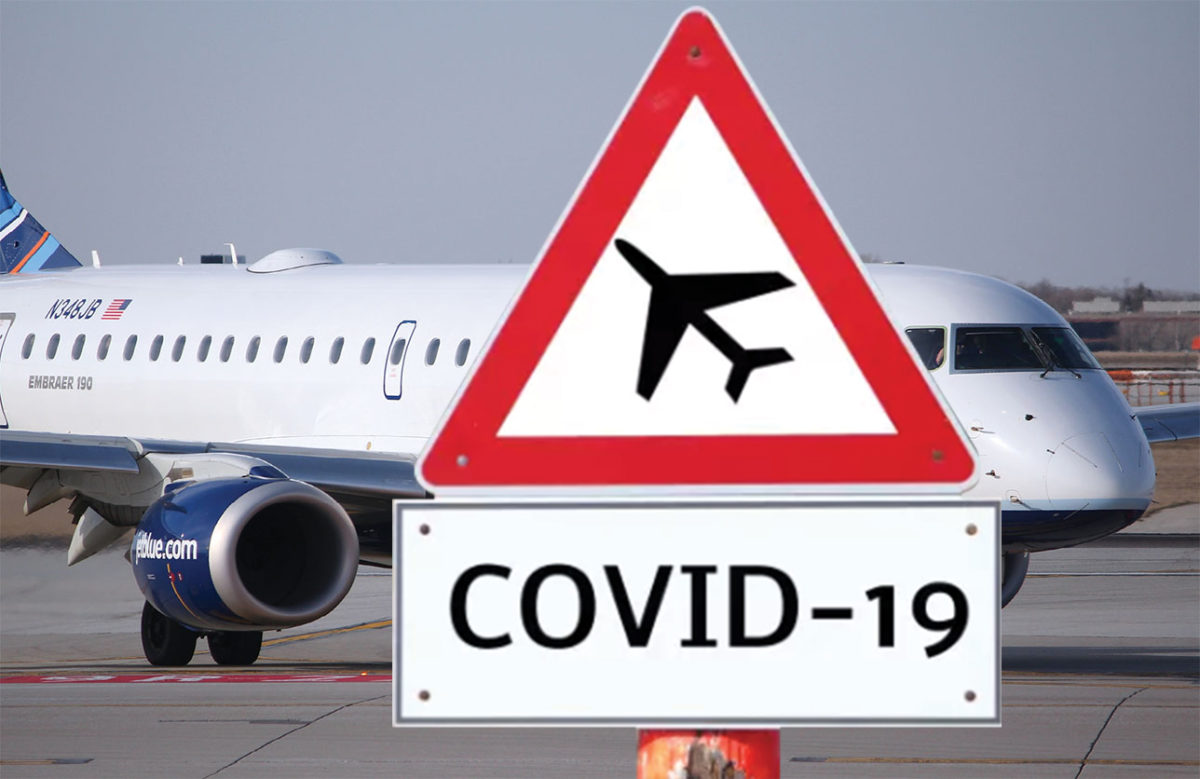With pretax losses for U.S. passenger airlines soaring to $46 billion last year due to Covid shutdowns and flying for business and pleasure being sharply curtailed, both of the major commercial airports in the lower Hudson Valley are being positioned as important fixtures in the economic recovery toolbox.
Westchester County Executive George Latimer told the Business Journal that an extra $8 million the federal government is allocating for Westchester County Airport is a welcome and helpful boost for the facility.
 However, Latimer said he did not yet know how the money could be used because the federal government had not issued necessary regulations and limitations. In addition, Latimer said his administration is poised to pick up the airport master plan effort that had been put on hold when the pandemic hit.
However, Latimer said he did not yet know how the money could be used because the federal government had not issued necessary regulations and limitations. In addition, Latimer said his administration is poised to pick up the airport master plan effort that had been put on hold when the pandemic hit.
A bit to the north, the Port Authority of New York and New Jersey, which controls New York Stewart International Airport in New Windsor, just outside of Newburgh, announced three initiatives designed to re-energize that airport.
They are: a new air carrier incentive program; a new airport marketing campaign to attract interest from across the airline industry to Stewart; and the completion of a new federal inspection station to help expedite operations to and from foreign destinations.
According to the trade association Airlines for America, New York state saw the largest reduction in air operations in the country as a result of Covid with a 57% decrease in flights. New Jersey was down 52%, while Vermont experienced a 56% reduction. Massachusetts experienced a 53% drop, as did Washington Reagan National Airport.
The trade group reported that as an industry, U.S. airlines will continue to burn up cash at least through the third quarter of next year and a return to prepandemic passenger levels is unlikely before late 2023.
According to Avports, the company that operates Westchester County Airport on behalf of the county, before the pandemic the airport was averaging 388 aircraft operations a day. It was home base for 301 aircraft and had six airlines operating on the field. Approximately 1.4 million passengers passed through the terminal building annually. Before the pandemic took its toll, business and leisure travelers using Westchester had a shopping list of cities that could be reached:
- American Airlines flew to Charlotte, Chicago and Washington, D.C.;
- Cape Air flew to Hyannis, Massachusetts, Lebanon, New Hampshire, and Martha”™s Vineyard, Nantucket and Provincetown, Massachusetts;
- Delta flew to Atlanta and Detroit;
- JetBlue flew to Fort Lauderdale, Fort Myers, Orlando, Tampa and West Palm Beach in Florida;
- United flew to Chicago;
- Tradewinds Aviation flew to Martha”™s Vineyard and Nantucket.
For part of last year there was no commercial service at the airport, but it has gradually been returning. In fact, on April 7, the airline Elite Airways announced it would begin jet service between Nantucket and Martha”™s Vineyard and Westchester at the end of May.
Before the pandemic, operations at Stewart were contracting after a positive splash that was made when foreign carrier Norwegian Air began flights to Europe in 2017. By 2018, 690,000 passengers a year were going through Stewart, but with the departure of Norwegian, the number dropped to 525,000 in 2019.
Avports also provides management services at Stewart and reported that before the pandemic the airport was averaging 114 aircraft operations a day and had 106 aircraft based on the field.
The Port Authority said American Airlines still flies between Stewart and its Philadelphia hub. Allegiant Air flies to Myrtle Beach, South Carolina, Punta Gorda, Orlando and St. Petersburg-Clearwater in Florida and plans to add new service to Savannah, Georgia, and Destin, Florida.
Business travel
“With Zoom and other platforms certain kinds of meetings now are comfortably done electronically and you”™re not going to need to do them in person the way you did before,” Latimer said. “You won”™t see corporate travel the way you did before. The industry, hotels, rental cars, airlines, corporate catering and event planning, there”™s going to be some diminishment of that.”
Latimer was quick to add that his past experience as an executive on the sales and marketing side of the hospitality industry leads him to believe that there will be certain types of business travel that will not only survive but thrive post-Covid and that bodes well for the airport.
“You can”™t do everything remotely. You”™ll do it remotely because there”™s a pandemic, but once the pandemic subsides and as more of the nation gets vaccinated people will feel more comfortable about travel,” Latimer said. “From a Westchester perspective, what we have to show is that we are ready in the short term to open back up and provide the services. You have two different kinds of travelers that go through that terminal, people traveling for business and people traveling for pleasure. It”™s an advantage for both who live in Westchester County to be able to go through Westchester Airport instead of having to go to LaGuardia.”
Latimer said that the comeback in business travel would be a national phenomenon and not something that was subject to local control.
“You need the overall volume of business travel to ratchet up much further than it is now before the commercial airlines serving Westchester start to come back to something like full service,” Latimer said.
“We vaccinate people, we try to get our infection numbers down but that intrinsically doesn”™t trigger decisions by the airline companies to start flying out of Westchester more. They need to see the overall business travel numbers nationwide jump up. Now, on the general aviation (GA) side, where you have corporate jets and the top-level executives who aren”™t going to get on a commercial flight, the GA business is down only a little bit now.“
Time for upgrades
Latimer said that while the current airport terminal building and parking structure are huge improvements over the World War II-vintage Quonset huts that were there for years, some improvements are needed.
“There are people who are worried that any improvements at the airport represent an expansion of travel and that”™s objectionable to them and we understand that. We are not here to expand the airport, that is not our mission,” Latimer said.
“On the other hand, when a person goes to the airport and it”™s peak usage and you have security to get through and the physical layout and logistics don”™t work we have to look at the airport. We”™re not going to go ahead with changes unless we dialogue with the neighbors and they recognize that what we”™re doing is not expansion. We”™re not adding more gates; we”™re not adding more passengers per half hour. If we can figure out any strategy with our general aviation partners that helps us reduce the number of flights then that strategy we would pursue as well.”
Latimer emphasized that his administration had met with The Business Council of Westchester and the Westchester County Association to discuss how they see the airport as part of the business community.
“The whole question of how we”™re planning for the future is embedded in the master plan process. When the pandemic hit everything got shut down. We looked at this and questioned how we could have a dialogue. We said we couldn”™t do the public input process properly so we just put it on hold,” Latimer said. “We need to know how everybody feels about it because it is a county asset.”
Latimer expressed a belief that the master plan will show a need to improve the terminal and then the question will become how to improve the terminal without expanding.
“You have that dialogue about an improved terminal with both the advocates on the side of controlling expansion and with people who are users who say ”˜This has got to be better; this has got to look different,”™” Latimer said.
Dialogue was an important buzzword for the Port Authority with respect to Stewart Airport, which initiated dozens of meetings with domestic and international air carriers to discuss potential routes that could carry planes and passengers to and from Stewart. Among the incentives offered airlines were waivers of fees for two years if they start serving Stewart or added new routes.
The authority said it plans to work with regional attractions such as the Storm King Art Center, Resorts World Catskills, Woodbury Common Premium Outlets, and the Legoland New York Resort to explore potential partnerships to grow tourism and air service in the region.
According to Port Authority Chairman Kevin O”™Toole, “Reenergizing New York Stewart has been a key goal of the Port Authority”™s mission to keep the entire region moving. The airport”™s location and market positioning are unique, and with improved international capacity, New York Stewart will continue to be an important low-cost alternative for the New York and New Jersey metropolitan region.”
The Port Authority plans to launch a marketing campaign targeting airline executives and route managers. It will highlight the airport”™s location in Hudson Valley”™s “apple country” and its proximity to New York City.


















